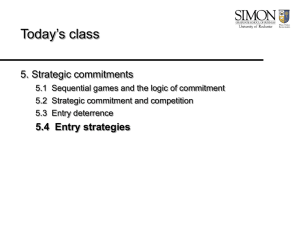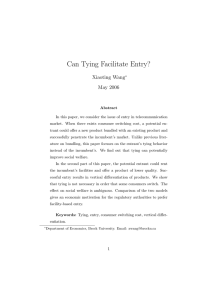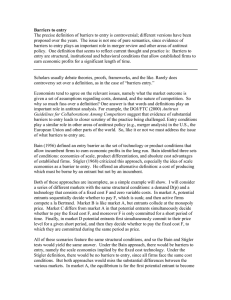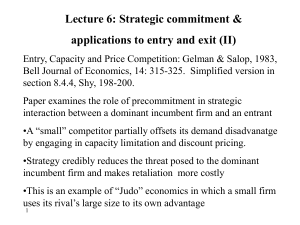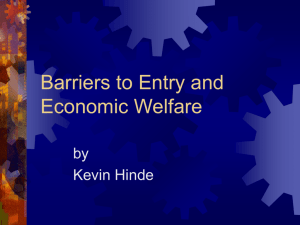Document 10466918
advertisement
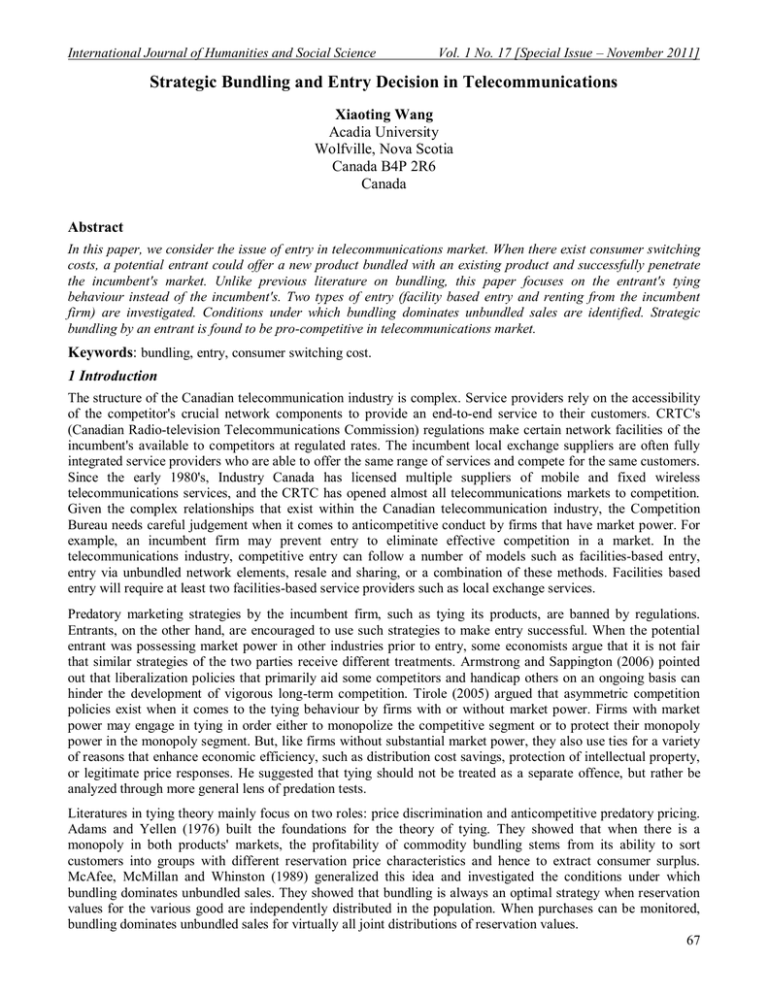
International Journal of Humanities and Social Science Vol. 1 No. 17 [Special Issue – November 2011] Strategic Bundling and Entry Decision in Telecommunications Xiaoting Wang Acadia University Wolfville, Nova Scotia Canada B4P 2R6 Canada Abstract In this paper, we consider the issue of entry in telecommunications market. When there exist consumer switching costs, a potential entrant could offer a new product bundled with an existing product and successfully penetrate the incumbent's market. Unlike previous literature on bundling, this paper focuses on the entrant's tying behaviour instead of the incumbent's. Two types of entry (facility based entry and renting from the incumbent firm) are investigated. Conditions under which bundling dominates unbundled sales are identified. Strategic bundling by an entrant is found to be pro-competitive in telecommunications market. Keywords: bundling, entry, consumer switching cost. 1 Introduction The structure of the Canadian telecommunication industry is complex. Service providers rely on the accessibility of the competitor's crucial network components to provide an end-to-end service to their customers. CRTC's (Canadian Radio-television Telecommunications Commission) regulations make certain network facilities of the incumbent's available to competitors at regulated rates. The incumbent local exchange suppliers are often fully integrated service providers who are able to offer the same range of services and compete for the same customers. Since the early 1980's, Industry Canada has licensed multiple suppliers of mobile and fixed wireless telecommunications services, and the CRTC has opened almost all telecommunications markets to competition. Given the complex relationships that exist within the Canadian telecommunication industry, the Competition Bureau needs careful judgement when it comes to anticompetitive conduct by firms that have market power. For example, an incumbent firm may prevent entry to eliminate effective competition in a market. In the telecommunications industry, competitive entry can follow a number of models such as facilities-based entry, entry via unbundled network elements, resale and sharing, or a combination of these methods. Facilities based entry will require at least two facilities-based service providers such as local exchange services. Predatory marketing strategies by the incumbent firm, such as tying its products, are banned by regulations. Entrants, on the other hand, are encouraged to use such strategies to make entry successful. When the potential entrant was possessing market power in other industries prior to entry, some economists argue that it is not fair that similar strategies of the two parties receive different treatments. Armstrong and Sappington (2006) pointed out that liberalization policies that primarily aid some competitors and handicap others on an ongoing basis can hinder the development of vigorous long-term competition. Tirole (2005) argued that asymmetric competition policies exist when it comes to the tying behaviour by firms with or without market power. Firms with market power may engage in tying in order either to monopolize the competitive segment or to protect their monopoly power in the monopoly segment. But, like firms without substantial market power, they also use ties for a variety of reasons that enhance economic efficiency, such as distribution cost savings, protection of intellectual property, or legitimate price responses. He suggested that tying should not be treated as a separate offence, but rather be analyzed through more general lens of predation tests. Literatures in tying theory mainly focus on two roles: price discrimination and anticompetitive predatory pricing. Adams and Yellen (1976) built the foundations for the theory of tying. They showed that when there is a monopoly in both products' markets, the profitability of commodity bundling stems from its ability to sort customers into groups with different reservation price characteristics and hence to extract consumer surplus. McAfee, McMillan and Whinston (1989) generalized this idea and investigated the conditions under which bundling dominates unbundled sales. They showed that bundling is always an optimal strategy when reservation values for the various good are independently distributed in the population. When purchases can be monitored, bundling dominates unbundled sales for virtually all joint distributions of reservation values. 67 The Special Issue on Humanities and Behavioral Science © Centre for Promoting Ideas, USA Whinston (1990) examines the consequences of tying where the market structure for the tied good is oligopolistic. He showed that through a pre-commitment to tying the monopolist reduces the sales of its tied good market competitor, thereby lowering his profits below the level that would justify continued operation. With heterogeneous valuations among consumers, tying can be a profitable strategy even in the absence of precommitment. This paper is a seminal paper in the tying literature, and has served as the theoretical foundation for judging predatory behaviour in antitrust cases. Nalebuff (2004) provides another reason why bundling may be used as a strategic entry deterrence tool. He considers a set-up where a firm with market power in two products can use bundling to make it harder for a potential entrant with only one of the products to enter the market. He argues that bundling is most effective as entry deterrence tool when consumers' evaluations for the two products are positively correlated. In this paper, we focus on the entrant's bundling behaviour. We show that when there are consumer switching costs, a potential entrant can use bundling to compensate them and make entry successful. In the next two sections, we will look at the role of bundling in two types of entry: facility-based entry and renting from the incumbent firm. In Section Four we will examine how the incumbent firm can optimally set a rental fee. Section Five concludes. 2 Facility-Based Entry 2.1 Setup The group of people we will focus on in this paper, are originally all firm I's (the incumbent's) customers in the market for product A. The amount of customers are a continuum of measure 1. Consumers are differentiated in their costs switching from firm I to firm E (the potential entrant) for buying one unit of product A. Assume switching costs t are uniformly distributed on (0, 𝑡). Consumers have unit demand for product A. The evaluation for product A is vA (constant) for all consumers. Consumers also have unit demand for product B. The willingness to pay for product B is vB (constant) for all consumers. Denote a consumer's utility function by 𝑉 𝑝𝐴𝐼 = 𝑣𝐴 − 𝑝𝐴𝐼 + 𝑣𝐵 − 𝑝𝐵 if he does not switch after entry has occurred. If a consumer switches to the individual product A offered by the entrant, his utility is given by 𝑉 𝑝𝐴𝐸 , 𝑡 = 𝑣𝐴 − 𝑝𝐴𝐸 − 𝑡 + 𝑣𝐵 − 𝑝𝐵 . His utility is given by 𝑉 𝑝 𝐴𝐵 , 𝑡 = 𝑣𝐴 + 𝑣𝐵 − 𝑝 𝐴𝐵 − 𝑡 if he switches to the bundle offered by the entrant. Before the entry game starts, firm I is a monopolist in the market of product A; firm E, the potential entrant into market for good A, competes with other firms in the market for product B. Suppose the market for B is composed of n firms. They offer identical products with constant marginal cost c. Assume 0 < c < 𝑡 < vA. The n firms in market B compete in prices. Price for product B is fixed in this paper at 𝑝𝐵 , where 𝑝𝐵 ≥ 𝑐. We will set the tiebreaking rule as follows. If n firms charge the same price for product B, the market share of any firm in this market is 1/n. Assume that demand for A and B are independent. So ex ante 1/n consumers from the target group purchases good B from firm E. For simplicity we assume that consumers' switching cost in market B is negligible. If firm E does enter market A, and offers an identical product as firm I, firm E has to pay a fixed cost F. Both firms produce A at zero marginal cost. We will model the entry problem as follows. Firm E decides whether to enter the market for product A. If firm E enters, it pays the fixed cost F, and sets price 𝑝 𝐴𝐵 for the bundle and 𝑝𝐴𝐸 for the individual product A. Firm I, observing whether entry has occurred (but not the prices set by firm E), chooses its own price 𝑝𝐴𝐼 . After observing the prices, consumers decide whether to switch to firm E's plan, or to stay with the incumbent firm. Before analyzing the equilibrium, we will briefly review the three types of bundling. “Pure component” is when products are sold individually and no bundles are offered. “Pure bundling” is the case when products are sold only in bundles and no individual products are offered. “Mixed bundling” is when products can be bought either in a bundle or individually. 2.2 Equilibrium Lemma 1: Pure component is a weakly dominated strategy. Proof: Since mixed bundling offers products both individually and as a bundle, mixed bundling can do at least as well as pure component. For example, if firm E uses the strategy of pure component, it offers product A and B individually at 𝑝𝐴𝐸 and 𝑝𝐵 . 68 International Journal of Humanities and Social Science Vol. 1 No. 17 [Special Issue – November 2011] However, firm E can earn at least as much by offering product A, product B and the bundle at 𝑝𝐴𝐸 , 𝑝𝐵 , and 𝑝𝐴𝐸 + 𝑝𝐵 . This argument holds no matter whether there is consumers' switching cost or not. Q.E.D. Lemma 2: When the market for product A is mature (no new consumers), and all consumers have identical evaluation vA for product A and vB for product B, firm E will choose to offer either pure component or pure bundling. Proof: Suppose firm E adopts the mixed bundling strategy, i.e. firm E offers product A both as an individual product and in a bundle. Consumers who switch to firm E's individual product A satisfy the following conditions, 𝑡 + 𝑝𝐴𝐸 < 𝑣𝐴 (1) 𝑡 + 𝑝𝐴𝐸 < 𝑝𝐴𝐼 (2) 𝑝𝐴𝐸 < 𝑝 𝐴𝐵 − 𝑝𝐵 (3) Consumers who switch to firm E's bundle satisfy these conditions, 𝑡 + 𝑝 𝐴𝐵 < 𝑣𝐴 + 𝑣𝐵 (4) 𝑡 + 𝑝 𝐴𝐵 < 𝑝𝐴𝐼 + 𝑝𝐵 (5) 𝑝 𝐴𝐵 < 𝑝𝐴𝐸 + 𝑝𝐵 (6) It is obvious that inequalities (3) and (6) can not hold at the same time. When a price for the bundle is not simply the sum of the prices for its components, firm E will sell either the bundle or the individual product A. Mixed bundling is redundant for firm E. Q.E.D. Given the results in Lemma 2, we can focus on firm E's optimal behaviour under each scenario. 2.2.1 Entry with Bundled Products Define 𝑡1 ∈ (0, 𝑡), such that consumers with switching cost t1 are indifferent between switching to firm E's bundle and staying with the incumbent's product A, i.e. 𝑉 𝑝 𝐴𝐵 , 𝑡1 = 𝑉(𝑝𝐴𝐼 ) (7) Solving for t1, we get 𝑡1 = 𝑝𝐵 + 𝑝𝐴𝐼 − 𝑝 𝐴𝐵 (8) 1 Lemma 3: When firm E enters the market for A using pure bundling strategy, firm E charges (2𝑐 + 𝑡 + 𝑝𝐵 ) for 3 1 its bundle; firm I charges 3 (𝑐 + 2𝑡 − 𝑝𝐵 ) for its product A. Proof: Firm E maximizes its profits 𝑡1 𝑝 𝐴𝐵 − 𝑐 − 𝐹 by choosing 𝑝 𝐴𝐵 . The first order condition for the optimization problem is, 2𝑝 𝐴𝐵 = 𝑐 + 𝑝𝐵 + 𝑝𝐴𝐼 (9) Firm I maximizes its profits (𝑡 − 𝑡1 ) ∙ 𝑝𝐴𝐼 by choosing 𝑝𝐴𝐼 . The first order condition is, 2𝑝𝐴𝐼 = 𝑡 − 𝑝𝐵 + 𝑝 𝐴𝐵 (10) Solving the above two equations jointly, we can get the equilibrium prices charged by each firm. Q.E.D. 1 1 It follows that the market share of firm E is 𝑡1 = 3 (𝑡 + 𝑝𝐵 − 𝑐). Firm E's profits equal to 9 (𝑡 + 𝑝𝐵 − 𝑐)2 − 𝐹 ; 1 Firm I's profits equal to (2𝑡 + 𝑐 − 𝑝𝐵 )2 . 9 2.2.2 Entry with Individual Product A Define 𝑡2 ∈ (0, 𝑡), such that a consumer with switching cost t2 is indifferent between switching to firm E's product A and staying with the incumbent firm, i.e. 𝑉 𝑝𝐴𝐸 , 𝑡2 = 𝑉(𝑝𝐴𝐼 ) (11) It follows that 𝑡2 = 𝑝𝐴𝐼 − 𝑝𝐴𝐸 (12) 𝑡 Lemma 4: When firm E enters the market for A with individual product, it charges for A; firm I charges 3 A. 2𝑡 3 for 69 The Special Issue on Humanities and Behavioral Science © Centre for Promoting Ideas, USA Proof: Firm E maximizes its profits 𝑡2 ∙ 𝑝𝐴𝐸 − 𝐹 by choosing 𝑝𝐴𝐸 . The first order condition is 𝑝𝐼 𝑝𝐴𝐸 = 2𝐴 (13) 𝐼 Firm I maximizes its profits (𝑡 − 𝑡2 )𝑝𝐴 by choosing 𝑝𝐴𝐼 . The first order condition is 2𝑝𝐴𝐼 = 𝑡 + 𝑝𝐴𝐸 (14) Solving the two equations simultaneously, we obtain the equilibrium prices. Q.E.D. 𝑡 1 4 It follows that the market share of firm E is 𝑡2 = 3. Firm E's profits are 9 𝑡 2 − 𝐹; firm I's profits are 9 𝑡 2 . Proposition 1: When market B is competitive, i.e. 𝑝𝐵 = 𝑐, firm E is indifferent between entering market A with and without bundling A with B. When firm E has market power in market B, i.e. 𝑝𝐵 > 𝑐, pure bundling dominates pure components for firm E. 1 1 Corollary 1: At 𝑝 𝐴𝐵 = 3 (2𝑐 + 𝑡 + 𝑝𝐵 ) and 𝑝𝐴𝐼 = 3 (𝑐 + 2𝑡 − 𝑝𝐵 ), firm E's share in market A is (𝑡 + 𝑝𝐵 − 𝑐)/3𝑡 . Firm E sells individual product B for a total of (2𝑡 + 𝑐 − 𝑝𝐵 )/3𝑛𝑡 consumers. Corollary 2: If firm E offers a bundle, all consumers will gain from the entry of firm E into market A. Proof: Before firm E's entry, Firm I was the monopoly in market A. It charges the monopoly price vA to all consumers. Consumer surplus comes only from the competitiveness in market B, i.e. 𝑣𝐵 − 𝑝𝐵 . After firm E's entry, consumers who switch to the bundle have consumer surplus greater than or equal to 𝑣𝐴 + 𝑣𝐵 − 𝑡1 − 𝑝 𝐴𝐵 . Substituting in the values for 𝑝 𝐴𝐵 and t1, the expression becomes 2 2 1 𝑣𝐴 − 𝑡 + 𝑣𝐵 − ( 𝑝𝐵 + 𝑐) 3 3 3 Under the assumption that 𝑣𝐴 > 𝑡 and 𝑝𝐵 ≥ 𝑐, this value is greater than 𝑣𝐵 − 𝑝𝐵 . For consumers who stay with the incumbent's product A, they will gain from the entry of firm E as long as 1 𝑝𝐴𝐼 < 𝑣𝐴 . Given that 𝑝𝐴𝐼 = 3 (𝑐 + 2𝑡 − 𝑝𝐵 ), clearly this group of consumers gain from firm E's entry as well. Q.E.D. Discussion When the entrant builds its own physical facility and provides product of the same quality as the incumbent's, it costs a large amount of capital investment. For firm E, in order to cover the fixed cost of entry (F) and the lost profits in market B, long-run profitability of selling A has to be considerably high. When setting up this model, we ignored the possibility for firm I to enter the market for B. The CRTC has put strict restrictions on promotions by the incumbents, in order to enhance the competitive market structure of the industry in the future. Iacobucci, et al (2005) argued that promotion by the incumbents is a reflection of competition, not deterrence to it. Here we admit that in the long run, it is possible for firm I to enter the market of B and provide bundled products. As stated in Matutes and Regibeau (1992),“A firm’s best response to mixed bundling by a rival firm is to engage in mixed bundling.” 3 Entry by Renting from the Incumbent Firm When the entrant rents the incumbent's technical facilities instead of building its own, the quality of the entrant's product will not exceed that of the existing product. Given the incumbent firm's product quality, the entrant will respond by offering a product of equal or lower quality. 3.1 Setup Consumer Preferences Classical models of vertical differentiation, such as Shaked and Sutton (1982, 1983), are built on the assumption that consumers have different initial wealth levels. Here we make the following assumptions. As in the previous section, all consumers are firm I's customers before entry begins. Assume that they all have identical evaluation vA for one unit of high-quality A provided by the incumbent firm. Consumers differ in their switching costs t. Assume t is uniformly distributed on (0, 𝑡 ). Switching costs here can be considered as a negative endowment to consumers. Instead of letting the agents be differentiated in two dimensions: initial income and switching costs. We make this assumption so that we can focus on the pure effect of switching costs. Consumers who were not firm I's customers are not considered in this model, since switching costs in market A do not apply to them. 70 International Journal of Humanities and Social Science Vol. 1 No. 17 [Special Issue – November 2011] For a consumer who switches to firm E's product A, his utility is given by 𝑈 𝑝𝐴𝐸 , 𝑡, 𝜇𝐸 = 𝜇𝐸 𝑣𝐴 − 𝑡 − 𝑝𝐴𝐸 + 𝑣𝐵 − 𝑝𝐵 For a consumer who switches to firm E's bundle, his utility is given by 𝑈 𝑝 𝐴𝐵 , 𝑡, 𝜇𝐸 = 𝜇𝐸 𝑣𝐴 + 𝑣𝐵 − 𝑝 𝐴𝐵 − 𝑡 For a consumer who does not switch after firm E's entry, his utility is given by 𝑈 𝑝𝐴𝐼 = 𝜇𝐼 𝑣𝐴 − 𝑝𝐴𝐼 + 𝑣𝐵 − 𝑝𝐵 𝜇𝐼 and 𝜇𝐸 are parameters measuring the quality of product A. Assume 𝜇𝐼 = 1, and 0 < 𝜇0 ≤ 𝜇𝐸 ≤ 1. Technology Assume as in the previous section that firm I produces a high quality product A at zero marginal cost. For the entrant, assume there is no fixed cost with entry. Assume the marginal cost for firm E to produce A increases in the quality of A chosen by firm E. For simplicity we assume that marginal cost equals to 𝜇𝐸 ∙ 𝑐, where 𝑐 is the access charge or rental fee set by firm I. The same quality parameter that consumers face is used here to reflect the marginal cost of providing such a product or service. Although in reality the access charge has several components in it, we assume that it's mainly the capacity of physical facilities rented, such as copper cable lines or fiber lines, determine this quality factor. In the next section we will allow firm I to strategically choose 𝑐 . For now we assume 𝑐 is constant and 0 < 𝑐 < 𝑡 < 𝑣𝐴 . Timing Let's consider a two-stage game. At stage one, firm E decides whether to enter the market for A and chooses the quality of its product A. No fixed costs need to be paid. The underlying assumption is that firm E rents from firm I for its physical facilities. At stage two, if entry occurs, firms compete in prices. Firm I sets price for A; firm E sets prices for its individual product A and the bundle. 3.2 Equilibrium In the current setup, firm E chooses its quality parameter 𝜇𝐸 . Two types of product A can potentially be vertically differentiated. Moreover, there is cost asymmetry between the incumbent and the entrant. Standard Bertrand equilibrium will not be the result of this game. 3.2.1 Entry with Bundled Products In this subsection, we will look at the case when firm E bundles its product A with product B. Price Competition Define 𝑡𝐵 ∈ (0, 𝑡 ), such that a consumer with switching cost 𝑡𝐵 is indifferent between staying with the incumbent's A and switching to the entrant's bundle at 𝑝 𝐴𝐵 , i.e. 𝑈 𝑝𝐴𝐼 = 𝑈(𝑝 𝐴𝐵 , 𝑡𝐵 , 𝜇𝐸 ) (15) Solving the above equation, we get 𝑡𝐵 = 𝑝𝐴𝐼 + 𝑝𝐵 − 𝑝 𝐴𝐵 − (1 − 𝜇𝐸 )𝑣𝐴 (16) Consumers whose switching costs are less than or equal to 𝑡𝐵 will switch to firm E's bundle, i.e. 𝑡𝐵 is the demand for firm E in market A. Demand for the incumbent firm I is therefore given by 𝑡 − 𝑡𝐵 . Lemma 5: Given the entrant's choice of quality 𝜇𝐸 for product A, the Nash Equilibrium in the price setting game is 1 𝑝𝐴𝐼 = 𝜇𝐸 𝑐 + 𝑐 + 2𝑡 − 𝑝𝐵 + (1 − 𝜇𝐸 )𝑣𝐴 3 1 𝐴𝐵 𝑝 = 2𝜇𝐸 𝑐 + 2𝑐 + 𝑡 + 𝑝𝐵 − (1 − 𝜇𝐸 )𝑣𝐴 3 when the entrant sells product A in a bundle. Proof: Assume firm E's profits in market B are negligible. (𝑝𝐵 does not have to be negligible, and it is exogenous in this paper.) Firm E chooses 𝑝 𝐴𝐵 to maximize 𝑡𝐵 ∙ (𝑝 𝐴𝐵 − 𝑐 − 𝜇𝐸 𝑐). The first order condition is necessary and sufficient for the maximum, 2𝑝 𝐴𝐵 = 𝜇𝐸 𝑐 + 𝑐 + 𝑝𝐴𝐼 + 𝑝𝐵 − (1 − 𝜇𝐸 )𝑣𝐴 (17) 71 The Special Issue on Humanities and Behavioral Science © Centre for Promoting Ideas, USA Firm I chooses 𝑝𝐴𝐼 to maximize (𝑡 − 𝑡𝐵 ) ∙ 𝑝𝐴𝐼 . The first order condition is necessary and sufficient for the maximum, 2𝑝𝐴𝐼 = 𝑡 − 𝑝𝐵 + 𝑝 𝐴𝐵 + (1 − 𝜇𝐸 )𝑣𝐴 (18) 𝐼 𝐴𝐵 Solving for 𝑝 and 𝑝𝐴 simultaneously, we could obtain the equilibrium prices. Q.E.D. Substituting equilibrium prices into the equation for 𝑡𝐵 , we can obtain the demand function for firm E, 1 𝑡𝐵 = 3 [𝑡 + 𝑝𝐵 − 𝜇𝐸 𝑐 − 𝑐 − 1 − 𝜇𝐸 𝑣𝐴 ] (19) Choice of Quality Lemma 6: When firm E bundles its product A with product B, the optimal quality for its product A is at 𝜇𝐸 = 1. Firm E earns positive profits at 𝜇𝐸 = 1. Proof: Given the demand function 𝑡𝐵 , firm E will choose 𝜇𝐸 ∈ [𝜇0 , 1] to maximize its profits. Profit function becomes 1 [𝑡 + 𝑝𝐵 − 𝜇𝐸 𝑐 − 𝑐 − 1 − 𝜇𝐸 𝑣𝐴 ]2 . 9 Second order conditions show that this profit function is convex in the quality parameter 𝜇𝐸 . Therefore firm E's optimal choice of quality will occur at one of the boundaries, i.e. either at 𝜇𝐸 = 1, or at 𝜇𝐸 =𝜇0 . 1 At 𝜇𝐸 = 1, firm E's profits are [𝑡 + 𝑝𝐵 − 𝑐 − 𝑐]2 . 9 1 At 𝜇𝐸 =𝜇0 , firm E's profits are 9 [𝑡 + 𝑝𝐵 − 𝜇0 𝑐 − 𝑐 − (1 − 𝜇0 )𝑣𝐴 ]2 . Since 𝑐 < 𝑣𝐴 , it follows that firm E's profit is maximized at 𝜇𝐸 = 1. Given that 0 < 𝑐 < 𝑡 and 𝑝𝐵 ≥ 𝑐, firm E's equilibrium profit at 𝜇𝐸 = 1 is above zero. Q.E.D. 3.2.2 Entry with Individual Product A Now let us look at the case when firm E enters the market for product A without bundling A with B. Price Competition Define 𝑡𝐼 ∈ (0, 𝑡), such that a consumer with switching cost 𝑡𝐼 is indifferent between staying with the incumbent's A at price 𝑝𝐴𝐼 and switching to the entrant's individual product A at 𝑝𝐴𝐸 , i.e. 𝑈 𝑝𝐴𝐼 = 𝑈 𝑝𝐴𝐸 , 𝑡𝐼 , 𝜇𝐸 (20) Solving the above equation, we get 𝑡𝐼 = 𝑝𝐴𝐼 − 𝑝𝐴𝐸 − (1 − 𝜇𝐸 )𝑣𝐴 . Consumers whose switching costs are less than or equal to 𝑡𝐼 will switch to firm E's product A, i.e. 𝑡𝐼 is the demand for firm E in market A. Demand for the incumbent firm I is therefore given by 𝑡 − 𝑡𝐼 . Lemma 7: Given the entrant's choice of quality 𝜇𝐸 for product A, the Nash Equilibrium in the price-setting game is 1 𝑝𝐴𝐼 = [2𝑡 + 𝜇𝐸 𝑐 + 1 − 𝜇𝐸 𝑣𝐴 ] 3 1 𝐸 𝑝𝐴 = [𝑡 + 2𝜇𝐸 𝑐 − 1 − 𝜇𝐸 𝑣𝐴 ] 3 when the entrant sells individual product A. Proof: Firm E chooses 𝑝𝐴𝐸 to maximize its profit 𝑡𝐼 ∙ (𝑝𝐴𝐸 − 𝜇𝐸 𝑐). The first order condition is necessary and sufficient for the maximum, 2𝑝𝐴𝐸 = 𝑝𝐴𝐼 + 𝜇𝐸 𝑐 − (1 − 𝜇𝐸 )𝑣𝐴 (21) 𝐼 Firm I chooses 𝑝𝐴 to maximize its profit (𝑡 − 𝑡𝐼 ) ∙ 𝑝𝐴𝐼 . The first order condition is necessary and sufficient for the maximum, 2𝑝𝐴𝐼 = 𝑡 + 𝑝𝐴𝐸 + (1 − 𝜇𝐸 )𝑣𝐴 (22) Equilibrium prices are obtained by solving these two first order conditions jointly. Q.E.D. Given the equilibrium prices, we can calculate demand for each firm in the market for A. Demand for the entrant is 1 𝑡𝐼 = [𝑡 − 𝜇𝐸 𝑐 − 1 − 𝜇𝐸 𝑣𝐴 ] 3 72 International Journal of Humanities and Social Science Vol. 1 No. 17 [Special Issue – November 2011] Choice of quality Lemma 8: When firm E offers product A as an individual product, the optimal quality for its product A is at 𝜇𝐸 = 1. Firm E earns positive profits at 𝜇𝐸 = 1. Proof: Let firm E choose an optimal quality 𝜇𝐸 ∈ [𝜇0 , 1] that maximizes its profit 𝑡𝐼 (𝑝𝐴𝐸 − 𝜇𝐸 𝑐 ). Firm E's profit function 1 can be rewritten as 9 [𝑡 − 𝜇𝐸 𝑐 − 1 − 𝜇𝐸 𝑣𝐴 ]2 . Second order conditions show that firm E's profit is convex in the quality parameter 𝜇𝐸 . So maximum profit will occur at one of the boundaries, i.e. either at 𝜇𝐸 =𝜇0 , or at 𝜇𝐸 = 1. 1 1 Firm E's profits at 𝜇𝐸 = 1 are 9 (𝑡 − 𝑐)2 . Its profits at 𝜇𝐸 =𝜇0 are 9 [𝑡 − 𝜇0 𝑐 − 1 − 𝜇0 𝑣𝐴 ]2 . For 𝑐 < 𝑣𝐴 , it follows immediately that firm E's profits are maximized at 𝜇𝐸 =1. Under the assumption that 0 < 𝑐 < 𝑡 , firm E's equilibrium profit is bounded above zero. Q.E.D. Notice that no matter entering the market with bundled goods or individual product A, the entrant will always choose the highest quality available, therefore pay the incumbent the highest rental fee or access charge to use its physical facilities. Vertical differentiation, although offered as a choice for the entrant, has not been adopted in this situation. 3.2.3 Subgame Perfect Equilibrium Proposition 2: If the market price for product B is at its marginal cost c, firm E faces the same level of profits whether it bundles (A and B) or not, and selling an individual product A is not a dominated strategy for firm E. Proof: 1 When firm E offers individual product A, its maximum profits are 9 (𝑡 − 𝑐 )2 . 1 When firm E offers product A in a bundle, its maximum profits are 9 (𝑡 + 𝑝𝐵 − 𝑐 − 𝑐)2 . At 𝑝𝐵 = c, two profit functions are equal. When 𝑝𝐵 > c, bundled sale dominates offering individual products. Q.E.D. 4 To Build or To Rent? In the previous two sections, we have derived the outcomes under each type of entry. Now the question is, will firm E choose to build its own facilities or to rent from the incumbent firm? To solve this question, let us consider the following setup of the game. Firm I first decides the rental fee 𝑐 . After observing 𝑐 , firm E will choose from the three options: renting from firm I; building its own facilities; not entering market A. Using backward induction, we first look at firm E's optimal choice. Not entering yields zero profit. When market B is perfectly competitive, i.e. pure bundling and pure components are equally profitable for firm E, renting yields 1 1 profits of 9 (𝑡 − 𝑐)2 ; building yields profits of 9 𝑡 2 − 𝐹. It follows immediately that renting from incumbent is more profitable if 1 𝐹 > 9 𝑐(2𝑡 − 𝑐 ) (23) Knowing how firm E will react to its rental charge 𝑐 , firm I will set 𝑐strategically. If firm E rents as in Section 3, 1 4 firm I's profits equal to 9 (2𝑡 + 𝑐 )2 . If firm E builds its own facilities as in Section 2, firm I's profits equal to 9 𝑡 2 . Clearly firm I's profits are always higher when firm E rents its facilities. From the above inequality, firm I by setting 𝑐 = 𝑡 − 𝑡 2 − 9𝐹, makes firm E rent from her in the equilibrium. This rental fee, however, has been strictly regulated in most telecommunications markets. The regulators will usually set the price cap below what is optimal for the incumbent firm. Such a regulated rental fee or access charge is the actual cost that the entrants face. In reality the entry decisions will not only depend on the comparison of the various costs, but also on the firm's forecast of market demand and its long term goals in the industry. 5 Conclusion Bundling has been proved to be a successful way of predatory pricing. If a firm is the monopolist in one market, it could use the leverage provided by this power to foreclose sales in and thereby monopolize another market. 73 The Special Issue on Humanities and Behavioral Science © Centre for Promoting Ideas, USA Bundling can also be a way of price discrimination if consumers have heterogeneous preferences. In this paper we take a different view at the bundling behaviour, and focus on strategic bundling by a potential entrant. We showed that when consumers have switching costs, bundling facilitates market penetration by the entrant and improves social welfare. The two types of entry studied here, i.e. facility-based entry and renting from the incumbent firm, are typical in the telecommunications industry. In both cases, we found that if the potential entrant has market power in its existing product, then bundling dominates unbundled sales by yielding higher profits. This type of strategic behaviour is usually encouraged by the regulatory authorities, as it introduces competition to the bundled good's market and increases consumer surplus. If there is no market power in its primary market, the potential entrant is indifferent between bundling and unbundled sale. Picture the scenario where the incumbent monopolist bundles its products prior to the entry game. Then without any cost advantage, the potential entrant will find it difficult to attract consumers through bundling of the same products, as long as a nontrivial switching cost exists. This gives us another rationale in understanding the scrutiny that an incumbent monopolist faces when bundling its products. References [1] Armstrong, M., and Sappington, D. (2006). Regulation, competition and liberalization. Journal of Economic Literature, 44(2), 325-366. [2] Iacobucci, E., Trebilcock, M., and Winter, R.A. (2006). The Canadian experience with deregulation. University of Toronto Law Journal, 56, 1-74. [3] Matutes, C., and Regibeau, P. (1992). Compatibility and bundling of complementary goods in a duopoly. Journal of Industrial Economics, 40, 37-54. [4] McAfee, R.P., McMillan, J., and Whinston, M. (1989). Multiproduct monopoly, commodity bundling, and correlation of values. Quarterly journal of Economics, 104, 371-384. [5] Nalebuff, B. (2004). Bundling as entry barrier. Quarterly Journal of Economics, 119, 159-187. [6] Shaked, A., and Sutton, J. (1982). Relaxing price competition through product differentiation. Review of Economic Studies, 49, 3-14. [7] Shaked, A., and Sutton, J. (1983). Natural oligopolies. Econometrica, 51(5), 1469-1483. [8] Tirole, J. (2005). The analysis of tying cases: a primer. Competition Policy International, 1(1), 1-25. [9] Whinston, M.D. (1990). Tying, foreclosure and exclusion. American Economic Review, 80(4), 837-859. 74
